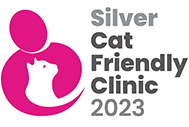Rabbits are wonderful pets and can form great bonds with their human owners, and (if paired well) with other rabbits.
They will require cleaning of toilet areas twice daily, morning and evening, by their human family members, together with regular handling to keep them biddable.
Extra care will be required in the winter months especially if the rabbits are housed outside. Similarly, you will need to have care plans for when you go on holiday. Rabbits can live up to ten years of age.
Diet
The most important requirement in a rabbit’s diet is fibre. At least 85-90 % of a rabbit’s diet should consist of eating hay, dried grass and grass.
It should also include a small portion of nuggets, (20-25g per kg based on the ideal body weight) a complete rabbit nugget diet is preferential to a muesli type diet where selective eating can occur resulting in health problems.
Water
Fresh water must always be available - and is important for maintaining urinary tract health.
Common problems seen in rabbits:
- Dental problems:
Rabbits teeth are continually growing. Eating hay helps to wear the teeth down and keep them at the optimum size. Overgrown teeth affect the rabbit’s ability to eat and drink.
- Digestive health:
Rabbits guts need to be continually moving, hence a rabbit needs always to be eating to prevent gut-stasis. A high fibre diet keeps the gut moving and stimulates appetite maintaining a healthy balance of the gut.
- Obesity:
Obesity can lead to liver dysfunction, chronic soft stools, ‘sticky bottom syndrome’, pressure sores on the hocks, and an increased risk of heart disease.
When rabbits digest their food they produce two types of dropping: the characteristic hard droppings, and also soft smelly droppings covered in a layer of mucous, these are known as caecotrophs and are rich in protein and vitamins, and are meant to be re-eaten by the rabbit. This process is known as caecotrophy. Rabbits on a high protein, high carbohydrate and low-fibre diet make too many caecotrophs, and rabbits that are overfed lose the urge to practice caecotrophy, which can lead to ‘sticky bottom syndrome.
- Fly strike:
Is when flies are attracted, most commonly to the rabbit’s bottom, when soft faeces stick to hair around the anus, as is the case in ‘sticky bottom syndrome’. The flies lay eggs, and the resulting maggot larvae will enter the rabbit’s internal cavities and feed off the rabbit. This can prove fatal if not dealt with immediately and in the early stages. The risk of Flystrike is greatest in hot humid weather. You should check your rabbits bottom on a daily basis - speak to your vet about preventative treatments, such as RearGuard or other fly and parasite repellent spot-on treatments
Diseases that can be vaccinated against:
There are two diseases that can be protected against by vaccination:
- Myxomatosis
- (R)VHD- There are currently two strains of this virus; 1 and 2
Myxomatosis is a viral disease. The incubation period is 5 to 14 days, and it is spread by biting insects and fleas, thus can still affect house-rabbits. The disease often proves fatal. Vaccination is required annually, or biannually in the case of a local outbreak.
RVHD1 has been present in the UK for decades, whereas RHVD2 was first noted in France in 2010 and since identified in the UK. Both strains are lethal, and have been recorded all over the UK, one should ideally vaccinate against both to protect your rabbits.
RVHD1 is a viral disease and is swift and efficient killer – almost all unvaccinated rabbits who catch RVHD die within a day or two. RVHD2 is also often fatal. Both strains of RVHD are spread by direct contact with infected rabbits, or indirectly via their urine or faeces. The viruses can survive for months in the environment, and can survive the cold very well. Examples of how RHVD can be spread include…
- Hay may have been in contact with infected wild rabbits as grass growing in the field.
- Birds or insects may transport the virus on their feet (or in their droppings) to your rabbit grazing on the lawn.
- The virus may be blown on the wind.
- You might bring the virus home on your feet, or your other pets’ feet (or car wheels) from infected wild rabbit droppings.
- You could bring the virus home on your hands or clothes.
There is a joint vaccination on the market to protect against Myxomatosis and RHVD1 -this is a yearly vaccination - Nobivac RHD-Myxo. Rabbits can be vaccinated from 5 weeks of age -on set of immunity is 3 weeks from vaccination.
There is a second vaccination on the market to protect against RHVD2 - Filavac RHD-2 vaccine - this is again a yearly vaccination, or in high risk situations every 6 months. Rabbits can be vaccinated from 10 weeks of age-on set of immunity is 7 days from vaccination
Speak to your vet about vaccination. It is generally recommended that a 2-week gap between the 2 vaccinations (Nobivac RHD-Myxo and Filavac RHD-2) is maintained.
Neutering:
Spaying of females: Involves removal of the ovaries and uterus. This can be performed when the doe is 4 to 6 months old. The positive benefits are; it removes the risk of developing womb cancer, and neutering also avoids behaviour changes associated with the female hormones such as aggression and pseudo pregnancy, i.e. pulling out her fur and nesting.
Castration of male rabbits: can be done as soon as their testicles descend usually around
3 ½ months of age. Note a male rabbit can still be fertile for two weeks post castration so bear this in mind, if you are housing with an entire female rabbit.
Worms:
Rabbits can carry and contract worms, for which there is a specific rabbit wormer. Those rabbits that are exercised outside where wild rabbits frequent, are particularly at risk of becoming infected.
Worming is recommended when a new rabbit is being introduced to an existing rabbit or importantly if they show signs of E cuniculi -a microscopic brain and kidney parasite- they will need a 28-day course of a rabbit wormer in this instance - speak to your vet about whether worming is appropriate and how frequently.
Immediate veterinary treatment:
Should be sought if your rabbit seems at all off colour, most importantly when any of the following signs are observed; lethargy, not eating, dirty rear end and signs of fly eggs.
Remember small animals perish quickly; if you notice a problem in the morning get it treated in the morning don’t leave it till the end of the day!
Further reading:
Useful and interesting information is available on the RWAF (Rabbit Welfare Association & Fund) website, and the Burgesspetcare.com





